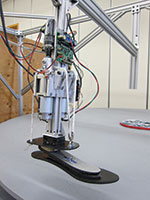Researchers at Michigan Technological University (Michigan Tech), Houghton, are developing a microprocessor-controlled foot-ankle prosthesis that they say comes close to achieving a natural gait and innate range of motion.

As part of their study, the team designed and built a large circular treadmill on which the robotic foot “walks” in circles. Photograph courtesy of Mo Rastgaar and Michigan Tech.
Mo Rastgaar, PhD, an assistant professor and the director of the Dynamic Systems and Human-Interactive Robotics lab, Department of Mechanical Engineering – Engineering Mechanics, and doctoral student Evandro Ficanha have designed an ankle-foot that can move on two axes, incorporating a side-to-side roll as well as raising the toe up and down. In testing, the prosthesis has been able to reproduce the angles of a human ankle while walking in a straight line and while turning.
“The microprocessor-controlled prostheses on the market can move an artificial foot in only one direction, toe up and toe down, which is fine if you are marking time on a treadmill,” said Rastgaar. “But in reality, we never walk in a straight line for any length of time. When you walk and reach an obstacle, you have to turn, and there’s always something in our way.”
The cable that moves the prosthetic ankle-foot is similar to those used in bicycle brakes. It runs from the control box to the ankle mechanism. The cable-driven mechanism moves the robotically controlled prosthesis and can turn the foot in almost any direction. Because the power and control mechanism is up and away from the leg, that lightens the prosthesis, making it much more comfortable and easy to use, Rastgaar and Ficanha said.
Kenton R. Kaufman, PhD, director of the Biomechanics/Motion Analysis Laboratory at the Mayo Clinic, Rochester, Minnesota, is collaborating in the effort to refine the prosthesis to make it available to those with lower-limb amputations, especially military personnel. “[Microprocessor-controlled prostheses] provide active control of the joint and improve safety and function,” said Kaufman. “But the advantage of Mo’s foot is that it is biomimetic-it mimics biology-so it allows a more natural walking pattern to occur, which should result in a better gait and fewer falls.”
The researchers said they expect to begin refining their design at the Mayo Clinic in the summer of 2014.
Editor’s note: This story was adapted from materials provided by Michigan Tech.




